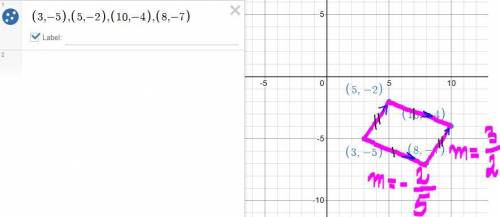
Mathematics, 21.07.2021 03:50 haleyturkey
Quadrilateral ABCD has coordinates A (3, -5), B (5, -2), C (10, -4), D (8, -7). Quadrilateral ABCD is a
•rectangle, because opposite sides are congruent and adjacent sides are perpendicular
•square, because all four sides are congruent and adjacent sides are perpendicular
• parallelogram, because opposite sides are congruent and adjacent sides are not perpendicular
•rhombus, because all four sides are congruent and adjacent sides are not perpendicular

Answers: 2


Another question on Mathematics

Mathematics, 21.06.2019 20:00
It is given that the quadratic equation hx²-3x+k=0, where h and k are constants, has roots [tex] \beta \: and \: 2 \beta [/tex]express h in terms of k
Answers: 2

Mathematics, 21.06.2019 23:40
Aright cylinder has a diameter of 8 m and a height of 6m. what is the volume of the cylinder
Answers: 1

Mathematics, 22.06.2019 01:30
(01.03 mc) which of the following is a step in simplifying the expression x multiplied by y to the power of 2 over x to the power of negative 3 multiplied by y to the power of 3, the whole to the power of negative 4. select one: a. x to the power of negative 4 multiplied by y to the power of negative 2, the whole over x to the power of negative 7 multiplied by y to the power of negative 1. b. x to the power of negative 4 multiplied by y to the power of negative 8, the whole over x to the power of 12 multiplied by y to the power of negative 12. c. x to the power of negative 4 multiplied by y to the power of negative 8, the whole over x to the power of negative 3 multiplied by y to the power of 3. d. x to the power of negative 4 multiplied by y to the power of negative 2, the whole over x to the power of negative 3 multiplied by y to the power of 3.
Answers: 3

Mathematics, 22.06.2019 03:00
Describe a pattern in each sequence what are the next two terms of each sequence -5, 5, -5, 5 a. subtract 10 from the previous term; -5,5 b. multiply the previous term by 1; 5, 5 c. add 10 to the previous term; -5, -15 d. multiply the previous term by -1; -5, 5
Answers: 1
You know the right answer?
Quadrilateral ABCD has coordinates A (3, -5), B (5, -2), C (10, -4), D (8, -7). Quadrilateral ABCD i...
Questions


History, 14.07.2019 17:30




History, 14.07.2019 17:30




Mathematics, 14.07.2019 17:30


Mathematics, 14.07.2019 17:30


History, 14.07.2019 17:30





Chemistry, 14.07.2019 17:30




